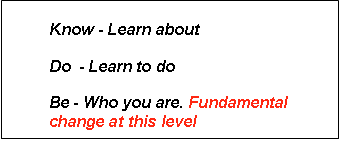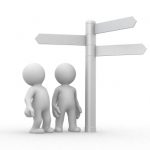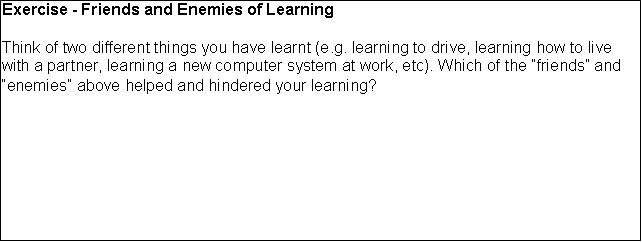A an extract from Mark Walsh’s upcoming book on the body and leadership
………….
Do you know how to learn? If you’re thinking yes then the answer’s no, or at least not very well. We have all learnt a lot since childhood and it is my experience that people’s ability to learn can diminish as people get older they don’t practice and close their minds. Lest I be accused of ageism I have seen this happen by the early-teens many times and not happen at all in octogenarians martial arts teachers who are perennial students. When we stop learning a part of us dies, and this book is about a deeper kind of learning than is common today, so this is worth spending a little time on.
First order learning is when we learn about something. This is intellectual factual knowledge like the capital of France is arrogance….I mean Paris. This type of “head-knowledge” is popular in most educational systems, and sadly has limited use. It can be taught though a Powerpoint or book like this one (though retention is better with other methods). You are doing it right now and there is a section on the theory of embodied training later in this chapter in this vein.
The next type of learning is learning how to do something – this is skills learning. Learning to speak French, learning to drive or learning many leadership skills are types of skills learning. Learning to do something usually takes more time than learning about something as practice and modelling is key. Nobody learns a language or to play an instrument  overnight – you need to put the hours in (10,000 to get really good according to Malcolm Gladwell). Similarly most of the skills in this book you can learn about very quickly – the ideas are simple enough – but take a little practice to achieve some skill in, and years to gain mastery in. After about 10,000 hours of practicing aikido which underpins many of the skills presented I feel I am just getting to the point where I really don’t understand the basics.
overnight – you need to put the hours in (10,000 to get really good according to Malcolm Gladwell). Similarly most of the skills in this book you can learn about very quickly – the ideas are simple enough – but take a little practice to achieve some skill in, and years to gain mastery in. After about 10,000 hours of practicing aikido which underpins many of the skills presented I feel I am just getting to the point where I really don’t understand the basics.
When we have lived with knowledge, learnt the hard way, processed internally and externally through practice, repetition and modelling others more skilled, then we really know something. “Knowledge is only a rumour until it is in the flesh” is an old saying one of my teachers is fond of quoting. Coming from a martial arts background where one practises the “basics” for life, I was a little shocked to find in the business leadership training world people thought they could pick-up a skill in a few hours. Learn about yes, learn to do well, no. I’m a bit of a practice Nazi and if you want to read this book without practising anything in it I’d impolitely suggest that you are wasting your time. If you don’t want to practice put this book down now! Note too that practice is often best a social matter as we are social animals and having communities of support for practice (e.g. golf clubs, Buddhist monasteries, Alcoholics Anonymous, etc) and a teacher who has been where you want to go (the literal meaning of “Sensei” in Japanese is one who has gone before) is highly advisable. You will not get these from this book but I hope it inspires you. In some ways a book about embodied training is a ludicrous notion, like trying to explain the taste of the Acai fruit to someone who has not tasted it. What books on food, wine and embodied training however can give is some names for distinctions which help you experience them later, that and some nice pictures which make you want to go out and dive in until the juice runs downs your chin!
who has been where you want to go (the literal meaning of “Sensei” in Japanese is one who has gone before) is highly advisable. You will not get these from this book but I hope it inspires you. In some ways a book about embodied training is a ludicrous notion, like trying to explain the taste of the Acai fruit to someone who has not tasted it. What books on food, wine and embodied training however can give is some names for distinctions which help you experience them later, that and some nice pictures which make you want to go out and dive in until the juice runs downs your chin!
The final kind of learning I’d like to mention is learning to be. Learning by changing at the level of who you are is the most powerful type of education and also the hardest to achieve. Learning at the level of being, or ontological learning is you’d like a word to impress your friends with, is a key part of embodied work. By changing the habitual shapes we hold ourselves in, we change how we think, what we are aware of as options, the nature of our relationships and who we are as people. Make no mistake, if you dive fully into embodied work you will change and for that to happen a part of you must die. There is always resistance to ontological learning as your system is set-up to defend itself and stay the way it is. This “homeostatic” tendency (named after the mechanism which regulates such factors as body temperature by George Leonard Sensei) is a powerful force and it takes motivation, diligent practice and usually community to overcome it. I am indebted to the Newfield coaching school of Santiago, Amsterdam and Boulder for introducing me to their notion of ”the coherence of the observer”. All this means is that we have an emotional, linguistic and embodied set of tendencies which see the world in a certain way, and if w e want real change and new options, we must change at this level not just try and do “more of the same”. Real change is at the level of self, and fiddling with events “out there” will not make the difference. A key sequence in this book is emerging and that is increased self-awareness leads to increased choices (making better ones possible). I never tell clients what they should do, I help them bring awareness to what they are already doing (which always serves a function or used to do at a time when it was the best option available) and help them develop alternatives to increase their range of chosen behaviours (skills) and way of being (ontological). Learning at this level is built through practices – conscious activities involving continual refinement (i.e. not just habits) over time.
e want real change and new options, we must change at this level not just try and do “more of the same”. Real change is at the level of self, and fiddling with events “out there” will not make the difference. A key sequence in this book is emerging and that is increased self-awareness leads to increased choices (making better ones possible). I never tell clients what they should do, I help them bring awareness to what they are already doing (which always serves a function or used to do at a time when it was the best option available) and help them develop alternatives to increase their range of chosen behaviours (skills) and way of being (ontological). Learning at this level is built through practices – conscious activities involving continual refinement (i.e. not just habits) over time.
It is also worth nothing that learning can be conscious or unconscious. A child who is hit may “learn” that might is right for example, moods (see chapter 5) and some skills are often learnt through immersion in communities and unconscious modelling. After six months of living in Brazil for example I had learnt a bunch of things that were embodied that nobody set out to teach me consciously and I wasn’t even aware of picking up until I got home. “Where did those hips come from!” was one comment from my mother on how I was moving for example, safe to say I don’t give her all the details 😉
Barriers to learning and learning styles
Some attitudes to learning seem to help people learn and others hinder them. There are also some “types” of learners which are not good or bad but worth knowing about. Some people for example learn best through hearing, others through looking and others through the body (the latter are woefully under-catered for in modern school and corporate education which is one benefit of embodied training). Some like to analyse, some to reflect, some to discuss. These factors will influence how best you get the knowledge from this book – you may need to talk it though with a friend for example or write your own notes, you may want to spend more time on pictures or imaging pictures or more on doing the exercises physically. If you don’t know your preferred operating system and learning style I recommend doing one of the free online tests – Google “learning styles tests” or “NLP representational systems test” – for some rough and ready insights.
Now, let’s look at barriers to learning. The following are some habits that I see slowing down people’s learning. If you think you may have any of these tendencies – and check with a someone who has seen you learn before and will give you honest feedback as we are often blind to our own “observers” – ask what you will need to do to inhibit this while engaging with this book so as not to waste your time. If like me for example you tend to “know it all” reminding yourself on starting each chapter to “empty your cup” as the Zen story goes may help. Other potential barriers include such things as:
• Needing to know/extreme relativism
• Being over-focused on solutions/relationships/yourself
• Reliance on theory/anti-intellectualism
• Perfectionism/sloppiness
• Being and expert
• Needing to please/displease
• Discomfort with body and emotions (e.g. unacknowledged fear and anger)
• Addiction to heaviness/ lightness
• Addiction to familiarity/novelty
• Not prioritising learning (often comes from not applying theory to application around issues that matter)/making learning too critical
• Lack or trust (not giving other permission to teach)/blind-faith
Note that many of these are polarities and it is the extremes which hinder learning. Being too serious or not taking anything seriously for example. Trickily from the viewpoint of an extreme it will be perceived as the middle as we are again, all blind to the observers we are.
I am indebted to Julio Olalla for the notion of “enemies of learning”. Conversely you can think of “friends of learning” such as:
• Open-mindedness, humility and critical thinking
• Acceptance and appropriate effort
• Willingness to make “mistakes”
• Acknowledging emotions and the body in learning
• Declaring yourself incompetent (the begging of any learning journey) and acknowledging current resources
• Having a sense of humour, playfulness and also taking what you do seriously
• Informed trust and giving teaching permission where appropriate
Sign up for our monthly Email Newsletter to get updates on the book and embodied learning


Cynthia Alle
I have been in the field of somatic education now for over 15 years and can’t really say enough about the difference embodied learning can make. Enjoyed your chapter. Look forward to your book. Our nonprofit is trying to bring embodied learning into the general ed classroom for kids and teachers. Reference material such as your book are important for moving forward in the university setting.
Mark Walsh
Wow, thanks Cynthia – deep bow to your work.